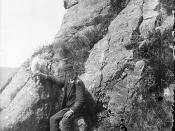Imagery in "Paul's Case"
The imagery used in a composition has a profound effect on perspective and interpretation. Just as one may see a rotten apple differently if it were described in flowery terms, the use of imagery can turn one's perspective in a different direction. In Cather's "Paul's Case," Paul's choice of suicide is thus justified through the juxtaposition of his two lives, that of the stage and of his home.
The first comparison that one comes across when reading the story is of the red carnation against Paul's overcoat. Throughout the story, Paul is symbolized by flowers, whether they are in a shop window, his hotel room, or against his overcoat. The vibrant carnation provides a look at Paul's spirit compared to the life he is forced to live by his father and teachers. Paul is eccentric and bright, just as the carnation, while he is forced to live a dreary life, void of any excitement and beauty.
For further insight into Paul's spirit, one can look at his admiration for the art in Carnegie Hall. While waiting to begin work, Paul visits the picture gallery and quickly becomes lost in the beauty of the paintings. His admiration of the art continues with Cather's explanation "that symphonies, as such, meant anything in particular to Paul, but the first sigh of the instruments seemed to free some hilarious and potent spirit within him.... He felt a sudden zest of life,...." Cather's wording seems to imply that Paul, in his natural state outside Carnegie Hall, was not really alive at all, at least in spirit.
Paul's life outside Carnegie Hall could be described as boring at best. The description of Paul's room with it's horrible yellow wallpaper, creaky bureau with it's greasy plush collarbox, and the...


![[Portrait of Les Paul, Fat Tuesday, New York, N.Y., ca. 1980s] (LOC)](https://s.writework.com/uploads/3/31608/portrait-les-paul-fat-tuesday-new-york-n-y-ca-1980s-loc-thumb.jpg)